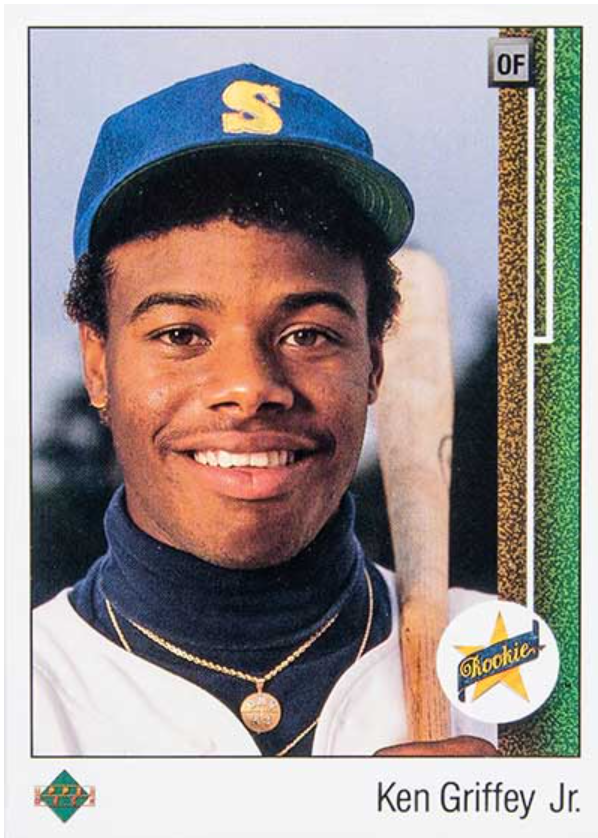In the vibrant tapestry of baseball history, few figures have etched themselves into both the hearts of fans and the annals of card collecting as indelibly as Ken Griffey Jr. His meteoric rise to fame in 1989 brought with it a wave of anticipation that has endured for fans and collectors alike. Ken Griffey Jr., with his flawless swing and uncontainable charisma, became more than just a player on the diamond; he became an icon whose presence continues to reverberate through the trading card universe.
Griffey’s card portfolio is as extensive as his legacy, with over 25,000 different cards capturing his career from the heyday of the late ’80s into the modern, glossy masterpieces of today. While some of these cards are as common as a sunny day in July, others are rarer than a perfect game in the World Series, fetching mind-boggling sums that could rival new cars.
In this curated journey through the hobby of card collection, we unveil the top 10 Ken Griffey Jr. cards that have become the stuff of legend, marked by their historical significance, scarcity, and sheer collector’s value.
Kicking off our list is the 1998 Metal Universe Precious Metal Gems #161, limited to a mere 50 copies. PMGs, as they’re affectionately known, ascended the trading card ranks in the late ’90s, electrifying the market with their scarcity and aesthetic allure. Just as Griffey electrified fans on the field, these PMGs do so off it, with a 2023 sale of a BGS 8 going for $54,000 serving as testament to their exalted status.
Jumping back to 1993, we find ourselves gazing at the luminous glow of the 1993 Finest Refractors #110. This card is not merely a collectible but a beacon, illuminating the path forward for trading card technology as the dawn of the Refractor era began and the Topps Chrome monolith started its ascent. With an estimated print of just 241 copies, owning one is akin to holding a piece of card-collecting archaeology.
Meanwhile, the 1998 SP Authentic Chirography #KG stands apart in Griffey’s autograph catalog with its streamlined design and visceral elegance. Limited to 400, its merging of signature and imagery captures “The Kid” in his most recognizable form: hat backward, joy unmistakable.
The pioneering spirit of the trading card is further embodied by the 1999 Upper Deck Game Jersey Autograph /24, one of the early birds of the game-used memorabilia frenzy. This rarity was at the forefront of a new era, with its tiny print run preserving its mystique among the serious treasure hunters of the hobby.
Not to be outdone, the 1989 Topps Traded Tiffany #41T scales the heights with gloss and premium appeal. While the standard version is ubiquitous, the Tiffany edition’s capped production of 15,000 sets swathes it in exclusivity, making this particular rookie edition a holy grail for completists.
Continuing the treasure trail is the 1997 Flair Showcase Masterpieces 1/1 #24, a forerunner in one-of-one collectibles. These solitary stars symbolize the chase and challenge, emblematic of a shift that gripped the hobby and gave rise to a whole realm of collecting built around the single, unique exemplars.
An epic meeting of legends unfolds with the 1994 Upper Deck Ken Griffey Jr. / Mickey Mantle Dual Autograph. This card fuses the legacies of two of baseball’s luminaries, a pantheon within a rectangle that saw a BGS 9.5 sell for $57,600 in 2022, demonstrating its reverential standing.
The journey turns revolutionary with the 1997 Upper Deck Game Jersey #GJ1. A relic of historical import, being one of the first game-used jersey cards, it laid the groundwork upon which countless others were built. With improbable odds of discovery (1:800 packs), it remains a rare jewel in Griffey lore.
The 1989 Bowman Tiffany #220 offers more rookie magic with a limited print run, making it a prize of both sentimental and numerical rarity, elevating the ordinary Bowman to extraordinary.
Finally, we arrive at the summit: the 1989 Upper Deck Rookie Card #1. It is the emblem of an era, the card that redefined, restyled, and rejuvenated the collecting world with its striking imagery and quality. A cornerstone of countless collections, its cultural cachet remains undiminished, with PSAs climbing into the thousands.
Across each of these glossy, cardstock windows into the past, the Griffey legacy looms large, transcending merely cardboard into treasures that tell stories of pivotal moments, unimaginable triumphs, and an everlasting love for the game. These cards are not merely collectibles; they’re time machines to an era when The Kid captured a nation’s imagination every time he stepped up to the plate. And so, with each Griffey card we collect, we add another thread to the rich, ever-expanding tapestry of baseball folklore.

